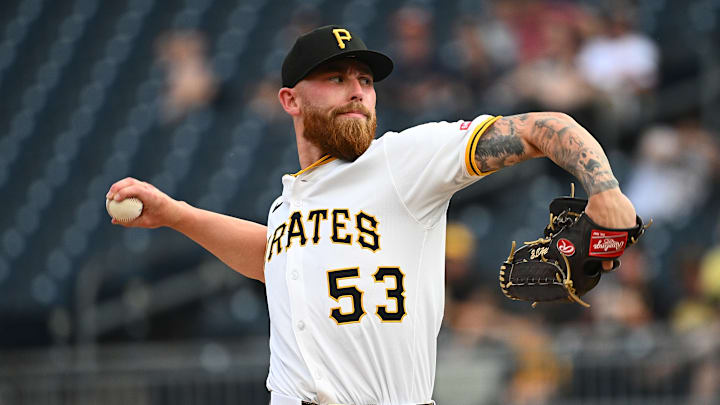The Pittsburgh Pirates saw Paul Skenes take home Rookie of the Year honors last year, the second player in franchise history to take home that honor. While Jackson Merrill had a strong rookie year, Skenes’ first campaign was nothing short of historic and the best by any rookie pitcher. But this year’s rookie class doesn’t have a clear-cut winner like last year. There isn’t one rookie who stands out further than the others at the moment, which means there could be a lot of candidates competing to make a second-half impression and secure the title.
One dark horse candidate nobody seems to have on their radar is Pirates’ right-hander Mike Burrows. Burrows owns a respectable 4.24 ERA, 4.18 FIP, and 1.29 WHIP across 23.1 innings this season. He has struck out a quarter of opponents and is in the top 74th percentile of whiff rate at 28.9%. Burrows has also been great at limiting walks, with a 7% BB%. However, home runs have given him some trouble, with a 1.54 HR/9 ratio.
These numbers do not stand out on paper. Fellow NL rookies like Logan Henderson, Cade Gibson, and Mick Abel have put up better numbers in about the same amount of innings. Division rival Chad Patrick has looked good through nearly 75 innings this season. Although they haven’t been used as starting pitchers, both LA Dodgers right-handers Ben Casparius and Jack Dreyer have pitched well in long-reliever/spot-starter swingman roles.
So what does Burrows do differently that could end up stacking up to these other rookie pitchers? For one, Burrows has a strong 3.38 xFIP. This adjusts for high HR:FB ratios, and Burrows currently sports an inflated 17.4% HR:FB ratio. This has been the main cause of his poor HR/9 ratio. Odds are he can improve in this area over time and throughout a larger sample size.
Mike Burrows' percentages should self-correct for Pirates on road to Rookie of the Year race
His flyball rate of 34.3% is lower than the league average of 38.3%. He is also in the 77th percentile of exit velocity at 88.1 MPH. Burrows’ 9% barrel percentage is below average, but shouldn’t be high enough to result in a HR:FB ratio so high. For reference, every qualified hitter this year with a HR:FB ratio between 17% and 18% has a barrel rate above 12.5%, except for Isaac Paredes (who takes advantage of a short right field porch in Houston).
Another ERA estimator Burrows is excelling in is SIERA (skill interactive earned run average). This is considered one of the most advanced ERA estimator stats, and Burrows sits at 3.51. Among rookie pitchers in the NL this season with at least 20 innings pitched, Burrows ranks third in xFIP and fifth in SIERA. For reference, last year’s American League Rookie of the Year winner, Luis Gil, had a 4.36 xFIP and 4.22 SIERA. Shoōta Imanaga, who finished fourth place in NL Rookie of the Year voting in 2024, had a 3.62 xFIP and 3.50 SIERA.
These aren’t the only metrics Burrows is doing well in compared to his fellow NL rookie pitchers. Burrows’ K% is the fifth-best among NL rookies with 20+ IP. He has an 18% K%-BB%, along with a 3.57 K:BB ratio, with the former ranking fourth and the latter ranking seventh. His exit velocity is also the fourth-lowest that anyone has induced.
While there aren’t many NL rookie position players doing exceptionally well, NL East catchers Liam Hicks and Drake Baldwin have both been standout hitters. Both have a wRC+ over 120. However, neither has reached at least 150 plate appearances this season. Only one rookie NL rookie, Agustin Ramirez, has put up an above-average wRC+ in 200+ trips to the dish so far into 2025.
There are rookie pitchers who are currently doing better than Burrows, and hitters who are doing the job as well, but there is still plenty of season left. At this point last season, Skenes had less than 40 innings under his belt in the Major Leagues. Burrows is doing well in multiple important metrics. One hot streak could catapult him into serious consideration for NL Rookie of the Year.
